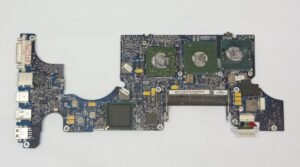Difference Between NLP and AI
Artificial Intelligence (AI) and Natural Language Processing (NLP) are two distinct fields that intersect in many ways but serve different purposes. Understanding the difference between these two technologies will help clarify their applications and avoid confusion when discussing them.
Key Takeaways
- AI and NLP are different fields within the broader domain of computer science.
- AI focuses on intelligent systems that can perform tasks without explicit programming, while NLP revolves around understanding and processing human language.
What is AI?
AI refers to the development of machines or computer systems capable of performing tasks that typically require human intelligence. It involves programming machines to simulate human-like behaviors such as learning, reasoning, problem-solving, and decision-making. AI can be further categorized into three subfields:
- Weak AI: Refers to AI systems designed to perform a specific task or a narrow range of tasks.
- Strong AI: Also known as artificial general intelligence, this refers to AI systems that possess human-level intelligence and can perform any intellectual task that a human can.
- Super AI: This hypothetical form of AI surpasses human intelligence and is capable of understanding, learning, and modifying itself.
*AI is a rapidly evolving field with ongoing advancements and breakthroughs.
What is NLP?
NLP is a subfield of AI that focuses on the interaction between computers and human language. It encompasses the development of algorithms and models to enable computers to understand, interpret, and generate natural human language. NLP is concerned with the following areas:
- Speech recognition: Converting spoken language into written text.
- Machine translation: Automatically translating text from one language to another.
- Sentiment analysis: Determining the attitude or emotion behind a piece of text.
- Information extraction: Identifying and extracting structured information from unstructured text.
*The goal of NLP is to bridge the gap between human language and machine understanding.
Comparison Table
| AI | NLP |
|---|---|
| Focuses on developing intelligent systems | Focuses on understanding and processing human language |
| Encompasses a broader range of tasks | Specifically deals with language-related tasks |
| Includes applications like computer vision and robotics | Includes applications like speech recognition and sentiment analysis |
Differences in Applications
A key difference between AI and NLP lies in their applications and areas of focus.
- AI Applications:
- Medical diagnosis and treatment
- Autonomous vehicles
- Recommendation systems
- Image and speech recognition
- NLP Applications:
- Virtual assistants and chatbots
- Machine translation services
- Text summarization and generation
- Sentiment analysis for social media monitoring
Data and Accuracy
Both AI and NLP rely heavily on data and accuracy, but their approaches differ.
- AI requires large datasets to train models and improve performance.
- NLP also relies on data but faces additional challenges such as language ambiguity and context understanding.
Data Comparison
| Data for AI | Data for NLP |
|---|---|
| Structured and unstructured data | Primarily unstructured text data |
| Image, audio, and numerical data | Speech transcripts, written documents |
| Often requires labeled data for supervised learning | May utilize both labeled and unlabeled data |
Future Directions
The fields of AI and NLP are rapidly evolving and hold immense promise for the future.
- The advancement of AI is leading to more sophisticated and capable intelligent systems.
- NLP is striving towards creating machines with a deeper understanding of human language and context.
*The continuous integration of AI and NLP applications will revolutionize industries and enhance user experiences across various domains.

Common Misconceptions
Misconception 1: NLP and AI are the same thing
One of the most common misconceptions is that Natural Language Processing (NLP) and Artificial Intelligence (AI) are synonymous. While they are related, they are not the same thing. AI is a broad field that focuses on creating machines capable of carrying out tasks that would typically require human intelligence. On the other hand, NLP specifically deals with the interaction between computers and human language.
- NLP is a subset of AI.
- AI encompasses various other fields like computer vision and machine learning.
- NLP focuses on the understanding and processing of human language.
Misconception 2: AI can automatically understand and interact with human language
Another common misconception is that AI systems can automatically understand and interact with human language without any human intervention or programming. While AI technologies have advanced significantly, achieving true understanding of human language is still a complex and ongoing challenge. NLP techniques and algorithms play a crucial role in enabling AI systems to process and make sense of human language.
- AI systems require careful programming and training to understand human language.
- NLP techniques help AI systems extract meaning from textual data.
- Human intervention is necessary to improve the accuracy and performance of AI systems in language understanding.
Misconception 3: AI and NLP will replace human jobs
There is a misconception that AI and NLP will eventually replace human jobs and make many professions obsolete. While AI technologies have the potential to automate certain tasks and transform industries, it is unlikely that they will completely replace human workers. Instead, AI and NLP are more likely to augment human capabilities, enabling humans to focus on higher-level tasks that require creativity, critical thinking, and emotional intelligence.
- AI is more likely to augment human jobs rather than replace them entirely.
- NLP can assist humans in tasks like language translation, customer support, and content generation.
- Human skills such as empathy, creativity, and problem-solving are still crucial for many jobs.
Misconception 4: NLP and AI are flawless in language understanding
Sometimes people believe that NLP and AI systems have capabilities similar to humans when it comes to understanding language. However, NLP and AI technologies still have limitations and can make mistakes in language understanding. The accuracy and performance of these systems heavily depend on the quality of data, training, algorithms, and models used.
- NLP and AI systems can sometimes misinterpret context, sarcasm, and nuanced meanings.
- Training data for AI systems needs to be carefully selected and relevant.
- Continual improvement and feedback are necessary for enhancing the language understanding capabilities of NLP and AI systems.
Misconception 5: AI and NLP are only used in advanced applications
Another misconception is that AI and NLP technologies are only used in complex and advanced applications or industries. In reality, various AI and NLP tools and applications are widely available and accessible to individuals and organizations across different fields. From chatbots and virtual assistants to language translation tools and sentiment analysis, AI and NLP have found their way into everyday applications and products.
- AI and NLP technologies are integrated into many consumer products and services.
- Chatbots and virtual assistants are common examples of AI and NLP applications.
- Many industries, including healthcare, finance, and retail, are leveraging AI and NLP for various purposes.

The Role of NLP in AI
Natural Language Processing (NLP) and Artificial Intelligence (AI) are closely related fields that have revolutionized various industries. NLP focuses on enabling computers to understand and manipulate human language, while AI aims to develop machines that can perform tasks that typically require human intelligence. In this article, we explore the differences between NLP and AI, highlighting key aspects that distinguish these two disciplines.
NLP vs AI in the Healthcare Industry
The healthcare industry has significantly benefited from both NLP and AI technologies. While NLP techniques have played a crucial role in extracting valuable insights from patient records and medical literature, AI has been employed to develop innovative diagnostic tools and personalized treatment plans.
Applications of NLP and AI in Social Media Analysis
Social media platforms generate an enormous amount of unstructured data, which can be effectively processed using NLP algorithms. On the other hand, AI algorithms can be used to analyze this data to gain valuable insights into consumer behavior, sentiment analysis, and target marketing strategies.
NLP and AI in Language Translation
NLP has made significant progress in machine translation, aiming to provide accurate and fluent translations between different languages. AI techniques have greatly enhanced translation quality, leveraging large language datasets and neural networks to improve accuracy and naturalness.
NLP and AI in Customer Service
With the advancement of AI-powered chatbots, customer service interactions have been transformed. NLP enables chatbots to understand and respond to customer queries in a more conversational and natural manner, providing quick and effective solutions.
Challenges and Ethical Concerns in NLP and AI
As NLP and AI continue to progress, several challenges and ethical concerns have emerged. These include bias in machine learning models, privacy concerns regarding user data, and the potential for AI systems to be used for malicious purposes.
Future Prospects and Innovations in NLP and AI
Both NLP and AI are rapidly evolving fields, presenting exciting prospects for the future. Innovations such as advanced deep learning models, reinforcement learning techniques, and multi-modal approaches are expected to push the boundaries of NLP and AI applications even further.
Impact of NLP and AI on Education
The integration of NLP and AI technologies in education has opened up new possibilities for personalized learning experiences. Intelligent tutoring systems, language learning apps, and automated grading systems are just a few examples of how NLP and AI are transforming the educational landscape.
NLP and AI in Autonomous Vehicles
NLP and AI technologies have made substantial contributions to the development of autonomous vehicles. Through NLP, these vehicles can understand voice commands, handle natural language interaction, and provide real-time updates and assistance to the passengers.
Collaboration between NLP and AI Experts
For the advancement of NLP and AI, collaboration between experts from both fields is essential. By combining their expertise, researchers and practitioners can develop powerful systems that can process and understand human language while exhibiting intelligent behavior.
In summary, NLP and AI are interconnected yet distinct disciplines that have revolutionized various industries. NLP focuses on enabling computers to understand human language, while AI aims to develop machines that exhibit intelligent behavior. The integration of these technologies has led to remarkable progress in healthcare, social media analysis, language translation, customer service, education, autonomous vehicles, and several other fields. Despite challenges and ethical concerns, the future prospects and innovations in NLP and AI hold great promise for transforming our world.
Frequently Asked Questions
What is the difference between NLP and AI?
Natural Language Processing (NLP) and Artificial Intelligence (AI) are related fields, but they have distinct differences. NLP focuses on the understanding and processing of human language, while AI is a broader discipline that encompasses various techniques to simulate intelligent human behavior.
How does NLP work?
NLP uses algorithms and machine learning techniques to analyze and understand human language. It involves tasks such as speech recognition, natural language understanding, and natural language generation.
What are the applications of NLP?
NLP has a wide range of applications, including language translation, sentiment analysis, chatbots, voice assistants, and information retrieval. It plays a crucial role in enabling machines to understand and interact with humans in a more natural way.
What are the main components of AI?
AI encompasses various components, including machine learning, computer vision, robotics, natural language processing, and expert systems. These components work together to create intelligent systems that can perform tasks that typically require human intelligence.
How does AI differ from NLP?
AI, as a broader field, goes beyond language processing and includes other aspects such as visual perception and decision-making. NLP, on the other hand, focuses specifically on analyzing and understanding human language.
Can NLP be considered a part of AI?
Yes, NLP is a subfield of AI that specifically deals with the interaction between computers and human language. It is an important component of AI systems that aim to simulate human-like intelligence.
What are the challenges in NLP?
NLP faces challenges such as ambiguity in language, understanding context, handling different languages and dialects, and capturing the complexities of grammar and semantics. Additionally, cultural differences, slang, and evolving language trends pose further obstacles.
How is NLP used in real-world applications?
NLP is employed in a variety of real-world applications, including voice assistants like Siri and Alexa, language translation services such as Google Translate, spam filters, sentiment analysis tools for social media, and information extraction from text documents.
Is AI limited to NLP?
No, AI is not limited to NLP. While NLP is a significant area within the AI field, AI encompasses various other components and technologies, including machine learning, computer vision, and robotics.
How are NLP and AI impacting society?
NLP and AI have the potential to revolutionize various aspects of society. They are driving advancements in healthcare, finance, customer service, transportation, and many other industries. However, ethical considerations and responsible deployment of these technologies are essential to ensure their positive impact.




